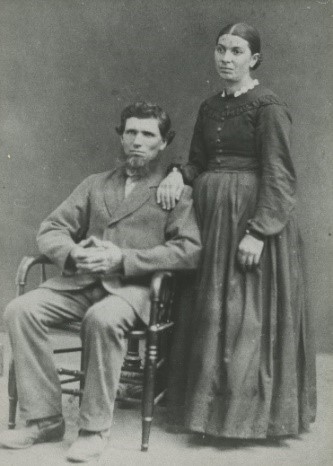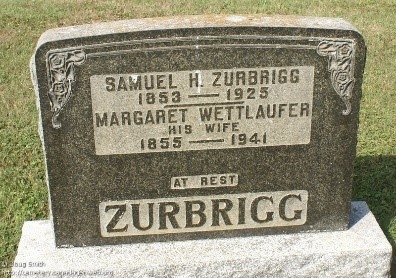Punkeydoodle's Corner - Part 2: The Stories Behind the Name
Punkeydoodle's Corner - Part 2: The Stories Behind the Name
Author and family history researcher Alayne Fulton Kleser delves into the family mystery surrounding the Zurbriggs' connection to the naming of Punkeydoodle's Corners in part two of her article.
By Alayne Fulton Kleser, author
Returning to Punkeydoodle’s Corner, the truth behind the stories is not at all clearcut. While they all agree upon the basic facts regarding the relationships between the Zurbriggs and the Zurbuchens, as well as on Samuel H’s varied occupations, each story also introduces different facets.
John Zurbrigg, for example, was described by Carrie as her mother’s first husband who died around 1860. She also noted that the couple had one son, Samuel H. Zurbrigg, who was born in 1853 and worked as a blacksmith. There were two branches of Zurbrigg’s that settled in the vicinity with four John’s between them, none of whom fit this description (a simplified tree is located at the end of this article). The first was the son of Gilgian Sr. and Elsbeth (Schmid) Zurbrigg. He was born in Switzerland in 1813 and married Susanna Buschlen just prior to the family’s departure for Upper Canada. He was killed after being hit by a train in 1868. The couple did have a son named Samuel, but he was a secretary/treasurer for The South Easthope Farmers' Mutual Fire Insurance Co., not a blacksmith.
Gilgian Sr. also had two grandsons named John. However, being born in 1837 and 1843 respectively, it is unlikely that either was the father of Samuel H. Both men also married women with the first name of Mary and lived far past 1860.

John and Lydia Zurbrigg
From the second branch, which arrived in North America around 1847, came the son of Anthony and Magdalena (Trachsel) Zurbrigg. He was born in 1836 and married Lydia Good in 1867. He died in 1922 and, like the first John, had a son of his own by the name of Samuel Good Zurbrigg, who owned a successful bakery in Ingersoll.
I turned next to the land records and found that the first Zurbrigg owner at Punkeydoodle’s Corner was, in fact, Gilgian Sr. Gilgian, his second wife (also Elsbeth), and their combined family arrived in New York in 1835 and made their way to Upper Canada. They eventually settled in Waterloo and Perth Counties, where Gilgian purchased three acres at Block A, Concession 3, Lot 29 in 1852.
According to the probate of his will, Gilgian died on April 1st, 1860, at the age of 74. The tax assessment records also confirm that Gilgian owned the land until 1859, and that John Zurbuchen maintained the property as of 1861. I have been unable to find any mention of a John Zurbrigg ever having owned this or any neighbouring property.

1857 Tax Assessment of Wimot Township
Moving on to Mrs. Helmer (the woman Carrie told us called John a “Punkeydoodle”), she appears to have been Mary Helmer the daughter of Colonel Anthony Van Egmond, a member of the prestigious Canada Company responsible for bringing settlers into the area. Mary’s husband, Andrew, owned a tavern which was described by the Lizar sisters as a “long, low log cabin, some 18 by 24 feet, with a lean-to for a kitchen.” Although the location of this tavern corresponds with Carrie’s story, being “up the road towards New Hamburg”, they were by no means the closest neighbour. Mrs. Helmer passed away in 1861, so if we are to believe Carrie’s story, the death date of John/Gilgian and Mrs. Helmer suggests that the name of Punkeydoodle’s Corner dates prior to 1860-1861.
According to Konrad Stock’s version of the story, John Zurbuchen was a German Tavernkeeper. In reality, he was a Swiss immigrant from Habkern, Switzerland, who married Elizabeth Hartung in 1860. At the time of the taking of the 1861 census, Samuel H. Zurbrigg was living with the couple. According to Carrie, with the marriage of John and Elizabeth, Zurbuchen inherited the land of John Zurbrigg, and this is where the tavern was opened. Looking to the tax assessment records, the tavern was relatively short-lived, running from approximately 1867 to 1873. So, if we believe this story, the name Punkeydoodle would have first appeared during this time.

1861 Census of Wilmot Township
The records all seem to confirm that Samuel H. Zurbrigg was born in 1853 and that he was raised by John and Elizabeth Zurbuchen. Shortly after his marriage to Margaret Wettlaufer in 1875, Sam moved for a time to Concession 3, Lot 11, South Easthope living next to the sons of John and Susanna Zurbrigg. In 1882, he sold the property and moved back onto the lands owned by Zurbuchen, eventually purchasing ½ an acre. Throughout his life, he worked as a blacksmith, operated a chopping mill, and ran a cider press.
Unfortunately, the records are not consistent in the naming of his parents. It is possible, however, that there is a clue in his middle initial. In the early years of Upper Canada, it was common for an individual to take as a middle initial, the maiden name of their mother to help differentiate themselves from others with the same name in the area (of which we know there were at least two). Samuel H’s marriage license lists his parents as Killian and Elizabeth Zurbrigg – was his mother Gilgian’s second wife, Elizabeth Hirschi? Or, more likely given the difference in age, was Elizabeth Hartung a much younger third wife to Gilgian, and mother to Samuel H.? While there is no direct proof, there is certainly circumstantial evidence supporting this theory. Not only does the 1861 census show that Samuel H. is living with the couple, but it also notes the death of a 74-year-old in the house the year before – the exact age of Gilgian when he died in 1860. It is also interesting to note that Elizabeth married John Zurbuchen just three months after Gilgian’s death: did the Lutheran community arrange for the quick marriage to ensure that she and her young son were cared for?

Riverside Cemetery, New Hamburg
Moving on to the pumpkin theory, it is possible that there might be some truth behind the addition of pumpkin to apple butter. Clayton was the grandson of Christian Merner and Elizabeth Zurbrigg. His grandparents had a farm just to the north of Zurbuchen and their children went to the same school section as Samuel H. In fact, both Christian and his brother, Jacob, gave a mortgage to Samuel H. and Gilgian Sr. appointed his “friend Jacob Merner” to be the executor of his will –the families were obviously well acquainted. Did Clayton’s mother pass down stories of the Zurbrigg’s of Punkeydoodle’s Corners to her only son?

Map courtesy of Google Maps
In the book "Pen Pictures of Early Pioneer Life in Upper Canada By a "Canuck”, written in 1905, the author wrote "Among people who had no orchards it was customary to make pumpkin sauce. The juice obtained was put into a kettle over the fire, sliced pumpkins, and sometimes sliced apples, being added". When Gilgian Sr. purchased the small parcel of land in 1852, is it possible that he had no orchard? Perhaps it was not greed that caused pumpkin to be added, but rather a lack of other resources.
On the other hand, it’s possible that the term Punkeydoddle had nothing to do with pumpkins at all. According to the Oxford English Dictionary, the term “Punky” refers to a person who cheats or deceives. The term “doodle”, on the other hand, was used as a verb in the sense “make a fool of or cheat”. This would suggest that the term “Punkeydoodle” was very much a derogatory term, inferring that the person in question was a cheat or produced items of poor condition. Is it possible that a member of the family upset a neighbour who took to calling him a “Punkeydoodle” to discredit him?
And yet, the lands surrounding Samuel H’s also came to be known as Zurbrigg’s Corners. As the Lizar sisters noted, the word “Corners,” came into use where “farms met a blacksmith’s shop… it became the nucleus of a village, the latter took its name from the man most prominent of the…residents”. While Gilgian did not have the time to establish himself in such a manner, we know that Samuel H. was a blacksmith, as well as operating a chopping mill and cider press. Online digitized references to Zurbrigg’s Corners dating back to 1913, speak to the importance of Samuel H. within the community.
Whatever the case, we do know that the extended Zurbrigg/Zurbuchen family did not like the name “Punkeydoodle”. Not only do we have Ernie’s tale of Samuel H. storming into the local newspaper office, but all the Zurbrigg and Zurbuchen obituaries of the area, right up until the 1950s, mention Zurbrigg’s Corner, while the neighbours all mention the name of Punkeydoodle.
It seems, therefore, that Carrie’s interview in 1938 may have been a concession that the name of Punkeydoodle won out, but that she was hoping to ensure the name of Zurbrigg somehow remained attached to the hamlet in honour of her half-brother, while at the same time protecting his good name.
In the end, more research must be done to try and determine exactly how far back the name goes.
At this point, all we can say for certain is that there does not appear to have been a John Zurbrigg who died in 1860 and that, as with most things, the passage of time has altered people’s memories of what happened. That being said, we have confirmed that Punkeydoodle’s Corner was also once known as Zurbrigg’s Corner and that the line of Samuel H. Zurbrigg is undeniably linked with the history of this hamlet.

Visit author Alayne Fulton Kleser's website for more information on the history of the Zurbrigg family at: zurbrigg.webs.com.